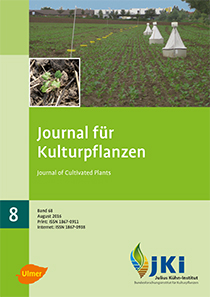Adults of Cabbage stem flea beetle (<em>Psylliodes chrysocephala</em> L.) in different types of yellow water traps in winter oilseed rape (<em>Brassica napus</em> L.)
Keywords:
Yellow water trap, cabbage stem flea beetle (Psylliodes chrysocephala), forecasting system, damage threshold, winter oilseed rapeAbstract
Yellow water traps are a decisive factor in the forecasting system for Psylliodes chrysocephala, the Cabbage stem flea beetle. In most parts of Germany a threshold of 50 imagines per yellow water trap within three weeks is established. In Germany two types of yellow water traps are widely used: an angular (26 x 33 cm) and a round type (22.4 cm diameter). The use of a grid at the top of the yellow water traps is recommended to prevent bees from drowning. The aim of this study carried out on 28 fields all over Germany was to investigate the effects of different types of yellow water traps on Cabbage stem flea beetle catches. Traps were used with and without grid and placed on the soil surface or dug into the soil. Beetle numbers differed significantly between some of the types of yellow water traps, but the difference in densities was in an acceptable range given the overall high variability induced by farmers.
DOI: 10.5073/JfK.2016.08.01, https://doi.org/10.5073/JfK.2016.08.01
Downloads
Published
Issue
Section
License
The content of the journal is licensed under the Creative Commons Attribution 4.0 License. Any user is free to share and adapt (remix, transform, build upon) the content as long as the original publication is attributed (authors, title, year, journal, issue, pages).
The copyright of the published work remains with the authors. The authors grant the Journal of Cultivated Plants, the Julius Kühn-Institut and the OpenAgrar repository the non-exclusive right to distribute and exploit the work.







